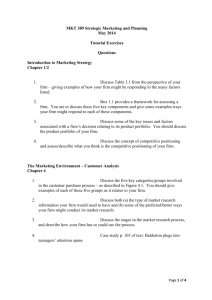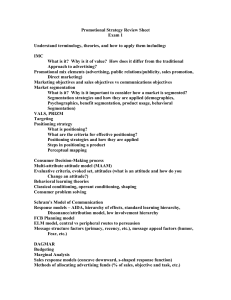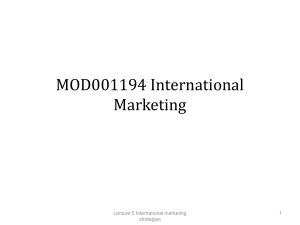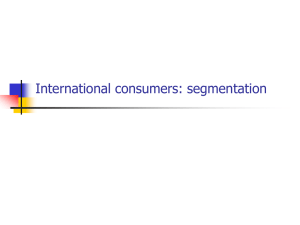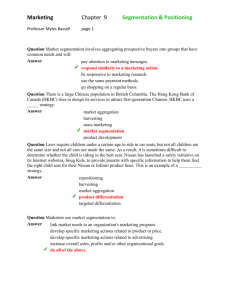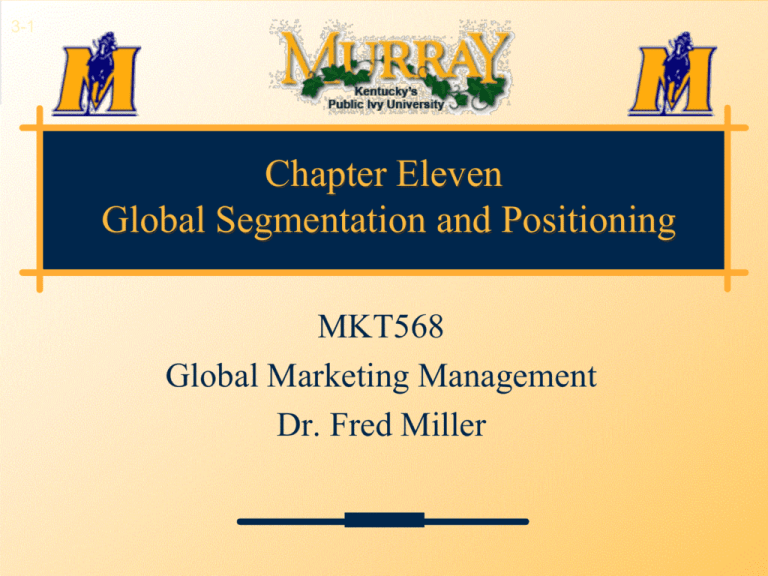
3-1
Chapter Eleven
Global Segmentation and Positioning
MKT568
Global Marketing Management
Dr. Fred Miller
Sample Essay Question
Schmidt’s Brewery has wishes to enter international markets with
several of its brands to increase sales and profit performance. The
firm has asked your for recommendations for segmentation and
positioning strategies to implement.
Write a short summary for Schmidt in which you: 1) explain
macrosegmentation using a specific clustering approach as an
example, 2) explain microsegmentation using specific segmenting
dimensions as an example and 3) explain product positioning and
describe how product space models in the countries they enter can
help them compete against local brands.
Market Assessment Tools
Global Marketer’s Mindset
Selling Orientation
Standardization
Coordination
Centralization
Macrosegmentation
Objective – identify groups of similar countries
Country clustering approaches
Selecting clusters using competitive &
profitability analysis
A Two-Dimensional
Country Clustering Map
4-11
0
• SWE
• DEN
NOR •
FIN• • UKI
•
• AUS
NEZ
• SWI
•
•
NET
SOT
•
• ISR
• AUT
GER
PUE • • • BEL
• JAP
FRA • CHI
• MAC
• VEN
• SPA
PHI • • BRA
TUR • IND
ITA•
•
• • • PER
•
•
• THI
PAK
ARG MEX COL
.9
.8
,7
.6
.5
.4
.3
.2
.1
0
-.1
-.2 -.1
0
Protestant
Exhibit 4.4
.1
.2
.3
Catholic
.4 .5 .6
Factor VI
.7
.8
.9
1.0
A Market-Oriented Clustering of
World Markets
Cluster
Demographic makeup
Climbers
Brazil, Venezuela,
Portugal, Mexico,
Taiwan, Malaysia,
Turkey, South Korea
Exhibit 4.5
Cont.
Population growth:
under 1.5%
Median age: slightly
higher than 20
Children: 2 to 3
GNP per capita: less
than $2,000
Luxury and leisure
societies
United States, Canada, Zero or very little
Japan, United
population growth
Kingdom, Australia
Median age: 30+
Children: 2
Reaching maximum
longevity
GOP per capita: greater
than $8,000
Marketing implications
Industrialization and service sector
expenditures assume greater
importance.
Private enterprises have become more
dominant than the state agencies.
Good opportunities for joint ventures
and technology agreements.
Growing mass market.
Substantial discretionary income and
availability of credit.
Restructuring of economy.
Maturing markets.
Intense competition.
Relocation away from large population
centers.
Source: Cavusgil, 1990, pp. 206-7. Reprinted by permission of Butterworth-Heinemann, Ltd.., and the author.
World Bank Comparative Data
Macrosegmentation Exercise
Why would a firm wish to identify clusters of similar country
markets?
How might a brewer use each of the following criteria to create
country clusters?
Climate
Language
Socioeconomic conditions
Religion
Geographic proximity
List a cluster of countries for each criterion.
Combine two criteria and list a cluster of relevant countries
with similar characteristics for the two criteria
Global Trends Cup
What are the relationships, do you think, among
these three socioeconomic measures? How do
you think each has changed around the world
between 1980 and 2005?
Women as a percentage of the workforce
Per capita income
Number of children per woman
Global Trends Cup
Enter a country name in each cell to place your bet.
The countries in the race are:
China
Mexico
Japan
Germany
Measure
Women as % of Labor Force
Per Capita Income
Children per woman
Highest value: 2004
Greatest change: 1980-2004
Global Trends Cup
And the winners are!
Measure
Highest value: 2004
Greatest change: 1980-2004
% Women in Labor Force
1-Germany, 2-China
1-Mexico, 2-Germany
Per Capita Income
1-Japan, 2-Germany
1-China, 2-Japan
Children per woman
1-Mexico, 2-China
1-Mexico, 2-China
Market Analysis Tools
Microsegmentation
Segmentation requirements
Identifiable, measurable, reachable, able/willing to buy
Segmenting bases
economic, demographic, culture – emerging, new growth
culture, benefits, lifestyle - mature
Global Product Positioning
Product space and components
New brand – space intact, extended, new
features/perceptions
“Mispositioning” of global brands – price, image, CoO
effects
Diversification vs Focus strategies
Demographic vs Lifestyle Segmentation
Microsegmentation Exercise
Why would a firm wish to use segmentation strategies in
individual national markets?
Select one of the following segmentation bases and explain
how it might be used in emerging and new growth country
markets.
Economic
Demographic
Culture
Select one of the following segmentation bases and explain
how it might be used in mature countries.
Culture
Benefits
Lifestyle
Product Space Positioning Exercise
Why would a firm wish to use positioning
strategies in individual national markets?
Which evaluative criteria should be used in a
two dimensional product space?
How are product perceptions represented in a
two dimensional product space?
How can positioning analysis using a product
space model help a firm compete more
successfully in national markets?
Building a Product Space
The Chinese Beer Market
Marketing Research Results
Factor
Importance Heineken
Imported
7
7
Price
3
3
Taste
5
5
Popularity
4
3
San Miguel Tsingtao
7
2
6
7
2
7
4
7
Building a Product Space Matrix
Dry
Tsingtao
7
Taste
Heineken
1
7
4
4
Domestic
Import
San Miguel
Malty
1
Imported
Market Positioning Map of Selected
Automobile Brands (1984)
Luxury
Conservative
• Lincoln
BMW •
• Porsche
4
Cadillac •
5
Mercedes •
• Chrysler 2
• Pontiac
• Buick
Oldsmobile •
• Chevrolet
Ford •
1
Dodge •
• Toyota
Plymouth •
Altima •
Sporty
• Datsun
3
• VW
Affordable
Source: John Koten, “Car Maker’s Use ‘Image’ Map as Tools to Position Products,” The Wall Street Journal,
March 22, 1984, pp. 31. Reprinted by permission of The Wall Street Journal, ©1984 Dow Jones & Company,
Inc. All rights reserved worldwide
Market Analysis Tools
Microsegmentation
Segmentation requirements
Identifiable, measurable, reachable, able/willing to buy
Segmenting bases
economic, demographic, culture – emerging, new growth
culture, benefits, lifestyle - mature
Global Product Positioning
Product space and components
New brand – space intact, extended, new
features/perceptions
“Mispositioning” of global brands – price, image, CoO
effects
Diversification vs Focus strategies
Market Factors Affecting
Choice of Expansion Path
Factors
Growth rate
Demand stability
Competitive lag
Spillover
Need to adapt product
Need to adapt promo
Marginal sales
Need for control
Entry barriers
Exhibit 5.8
Sprinkler/
Diversify if
Low
Low
Short
High
Low
Low
Diminishing
Low
Low
Waterfall/
Focus if
High
High
Long
Low
High
High
Increasing
High
High
3-1
Chapter Eleven
Global Segmentation and Positioning
MKT568
Global Marketing Management
Dr. Fred Miller
Export Pricing Problem
1.
€ 0,36 per liter, using the formula
Direct Unit Cost = Unit Labor Cost +Unit Ingredient Cost € 0,12 +
€ 0,24 = €0,36
2.
€,38 per unit, using the formula:
Unit Cost = Unit Variable Cost + Unit Fixed Cost where
Unit Fixed Cost = Total Fixed Costs / Volume in Units
€0,38 = €0,17 + €0,21 (€ 3.800.000/22.000.000 units)
3. € 0,64, calculated using the formula:
Price = Cost / (1 – Margin) or €0,64 = €0,38 / (1 - ,4)
4.
€ 0,66 FAS LA (€ 0,64 + € 0,02 domestic shipping)
Export Pricing Problem
5.
€ 0,70 CIF Bangkok, (€ 0,66 + € 0,03 international shipping and
€ 0,01 insurance)
6.
€ 0,78 DDP, CIF Price * (1 + Tariff Rate) so € 0,70 * 1,12
7.
€ 0,98, calculated using the formula:
Price = Cost / (1 – Margin) or € 0,98 = € 0,78 / (1 - 0,2)
8. € 0,10, using the formula:
(Retail Price * VAT Rate) so (€ 0,98 * 0,1)
Export Pricing Problem
9.
€1,08, using the formula:
(Retail Price + VAT) so (€ 0,98 + € 0,10)
10. 9,20 Bahts, (Final Price * Exchange Rate) or €1,08 * 40
11. €130.000, using the formula:
((Price – Full Cost) * Order Volume) or ((€ 0,64- € 0,38) *
500.000)
12. €100.000, using the formula:
((Retail Price – Retailer’s Cost) * Order Volume) or
((€ 0,98-€ 0,78) * 500.000)
Export Pricing Problem
Identify and explain two approaches the firm might use to
avoid the price escalation experienced in this situation.
1.
2.
3.
4.
5.
Reduce cost through lower quality materials
Reduce price resulting in lower profit margins
Change customs classification to lower tariffs
Shorten distribution channels to reduce intermediary markups
Produce in target country, eliminating tariffs, international
shipping and insurance costs

